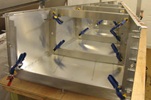


random user submitted photo
Rocker Stand Failure
4 posts
• Page 1 of 1
Rocker Stand Failure
Found during Condition Inspection today. AeroVee 2.1 - Engine at 468hours. Last inspected for head torquing at 442 hours. Failure could have occurred at any time in this interval as the stud that holds the rocker stand down was also holding the parts together.
Rockers original to engine kit.
Metal looks quite "granular" on the break.
With Lou's recent rocker ARM failure. Makes you wonder how many of the AeroVee unexplained power loss issues are related to rocker gear?
CLICK EACH PICTURE TO SEE AS INTENDED
Rockers original to engine kit.
Metal looks quite "granular" on the break.
With Lou's recent rocker ARM failure. Makes you wonder how many of the AeroVee unexplained power loss issues are related to rocker gear?
CLICK EACH PICTURE TO SEE AS INTENDED
Graeme JW Smith
-

GraemeSmith - Posts: 939
- Joined: Sat May 18, 2019 8:58 am
- Location: RI
Re: Rocker Stand Failure
The AeroVee and VWs are very good engines with a longer history of success than most any other engine in the world, and with good mainstream market parts. VWs can tolerate a lot of slop and still keep running. It's absolutely not fair to make unsubstantiated statements like "Makes you wonder how many of the AeroVee unexplained power loss issues are related to rocker gear." The vast majority of engine failures can be and have been traced to errors in construction, not failures of parts.
The rocker block is a cast part. The metallurgy of that part is such that it will always look "granular" when broken. There's nothing insidious about what we see there.
When I first put my engine together I cracked one of those, just like in your photo. The issue was that the rocker shaft holes are not symmetrical at at each end of the hole; they are flared at one end. The flare matches up with the flare in the head stud they are mounted on. If the rocker shaft flare is installed facing up at the nut instead of facing down toward the pistons, when you tighten the hold down nuts the rocker blocks will not be sitting flat on the shims (there will be a gap), and will crack when you tighten them down. That's the error I made. I'm not saying that's what happened, but it's one example of an assembly error that would LOOK like a failure of the part unless you really knew what you were looking for.
If the hold down nuts are over torqued, that could crack the rocker blocks, too. If the rocker arms are not gapped properly (too tight), that can crack a rocker arm or bend a pushrod. Both of these are also errors in construction. Metals have limits, and if you exceed them, they fail.
My 2 cents...
The rocker block is a cast part. The metallurgy of that part is such that it will always look "granular" when broken. There's nothing insidious about what we see there.
When I first put my engine together I cracked one of those, just like in your photo. The issue was that the rocker shaft holes are not symmetrical at at each end of the hole; they are flared at one end. The flare matches up with the flare in the head stud they are mounted on. If the rocker shaft flare is installed facing up at the nut instead of facing down toward the pistons, when you tighten the hold down nuts the rocker blocks will not be sitting flat on the shims (there will be a gap), and will crack when you tighten them down. That's the error I made. I'm not saying that's what happened, but it's one example of an assembly error that would LOOK like a failure of the part unless you really knew what you were looking for.
If the hold down nuts are over torqued, that could crack the rocker blocks, too. If the rocker arms are not gapped properly (too tight), that can crack a rocker arm or bend a pushrod. Both of these are also errors in construction. Metals have limits, and if you exceed them, they fail.
My 2 cents...
Mike Smith
Sonex N439M
Scratch built, AeroVee, Dual stick, Tail dragger
http://www.mykitlog.com/mikesmith
Sonex N439M
Scratch built, AeroVee, Dual stick, Tail dragger
http://www.mykitlog.com/mikesmith
- mike.smith
- Posts: 1430
- Joined: Tue Jan 29, 2013 8:45 pm
Re: Rocker Stand Failure
Graeme, does your engine have bolt together rocker shafts, or does it use the stock "wavy washers" and hairspring clips?
- karmarepair
- Posts: 193
- Joined: Sun Oct 11, 2020 8:13 pm
Re: Rocker Stand Failure
Happy to take Mike's comments (otherwise why post?).
Just as follow up - Unless mu torque wrench needs calibrating - correctly torqued.
And aware of the taper stud to shaft issue. Wasn't that.
Bolt together rocker - not wavy washer.
Just as follow up - Unless mu torque wrench needs calibrating - correctly torqued.
And aware of the taper stud to shaft issue. Wasn't that.
Bolt together rocker - not wavy washer.
Graeme JW Smith
-

GraemeSmith - Posts: 939
- Joined: Sat May 18, 2019 8:58 am
- Location: RI
4 posts
• Page 1 of 1
Who is online
Users browsing this forum: No registered users and 27 guests







